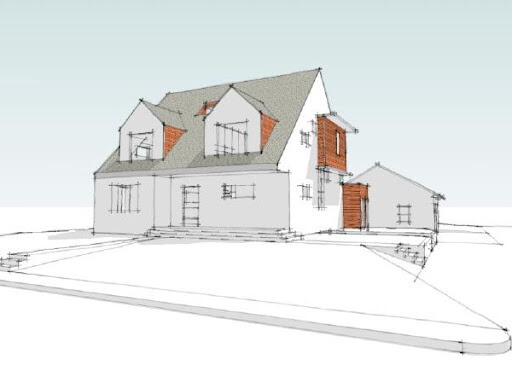Introduction: Why Energy Efficiency Matters in Alaska

Building an energy-efficient home in Alaska isn’t just about embracing sustainability—it’s about adapting to one of the most challenging climates in North America. With long, cold winters and high energy demands, building an energy-efficient home can drastically reduce heating costs, increase comfort, and enhance property value. In recent years, energy-efficient home construction has gained momentum among homeowners, developers, and custom home builders in Alaska who understand the importance of blending modern technology with Alaskan practicality.
In this comprehensive guide, we’ll explore the essential steps, materials, and strategies to help you design and build a home that not only withstands Alaska’s climate but thrives in it—saving you money and ensuring long-term sustainability.
Understanding Alaska’s Climate Challenges
Before you begin building an energy-efficient home, it’s crucial to understand the environmental factors that make Alaska unique.
- Long heating season: In many parts of the state, heating is necessary for eight to nine months of the year.
- Extreme temperature variations: From coastal humidity to interior subzero temperatures, Alaska demands highly adaptable designs.
- Limited daylight in winter: Impacts passive solar design strategies.
- Remote locations: Increase the cost and complexity of materials transport for energy-efficient home construction.
By understanding these conditions, custom home builders in Alaska can tailor your design to maximize energy savings and comfort.
Step 1: Choosing the Right Location and Orientation
Site selection plays a key role in energy-efficient home construction. When deciding how to build a house in Alaska for optimal efficiency, consider:
- Maximizing passive solar gain: Position your home so that its largest windows face south, capturing natural heat and light.
- Wind protection: Use natural land features or plant windbreaks to reduce heat loss from strong winter winds.
- Elevation: Higher elevations may receive more sun but can also face harsher winds.
Thoughtful site planning reduces energy demands and makes building an energy-efficient home more effective.
 Step 2: Designing for Energy Efficiency
Step 2: Designing for Energy Efficiency
An energy-efficient home in Alaska must combine insulation, airtightness, and smart layouts. Some key design principles include:
- Compact shapes: Reduce exposed surface area to minimize heat loss.
- Zoned heating: Focus heat where you spend the most time.
- Thermal mass: Materials like concrete floors absorb and release heat, helping to regulate indoor temperatures.
- Covered entries: Reduce drafts and help maintain a stable indoor climate.
Working with experienced custom home builders in Alaska ensures your home design aligns with the latest efficiency standards.
Step 3: Superior Insulation for Alaskan Winters
Insulation is the cornerstone of energy-efficient home construction in Alaska.
Recommended Insulation Levels
- Walls: R-30 to R-40
- Roof/attic: R-60 or higher
- Floors: R-30 to R-40
Materials to Consider
- Spray foam: Excellent for sealing gaps and creating an airtight barrier.
- Rigid foam boards: Ideal for continuous insulation over framing.
- Fiberglass batts: Cost-effective but must be installed with precision.
Proper insulation ensures your energy-efficient home in Alaska maintains warmth without relying on excessive heating.
Step 4: Airtight Construction and Ventilation
Airtight construction prevents warm air from escaping and cold air from seeping in, a critical step in building an energy-efficient home.
- Air sealing: Use caulking, spray foam, and weatherstripping to close all gaps.
- Blower door testing: Confirms the home meets airtightness standards.
- Mechanical ventilation: Install an HRV (Heat Recovery Ventilator) or ERV (Energy Recovery Ventilator) to bring in fresh air while retaining heat.
A well-sealed home paired with controlled ventilation balances energy savings with healthy indoor air quality.
Step 5: High-Performance Windows and Doors
Windows and doors are major points of heat loss, so investing in high-performance models is essential for energy-efficient home construction.
Key Features to Look For
- Triple glazing: Reduces heat loss and condensation.
- Low-E coatings: Reflect heat back inside during winter.
- Insulated frames: Prevent cold transfer through the window structure.
- Tight seals: Reduce air infiltration.
Strategically placing and sizing windows also helps with passive solar heating in energy-efficient homes in Alaska.
Step 6: Heating Systems for Maximum Efficiency
Even the best-insulated energy-efficient home in Alaska needs an effective heating system. Options include:
- High-efficiency boilers or furnaces: Fuel-efficient and reliable.
- In-floor radiant heating: Distributes heat evenly and retains warmth.
- Air-source or ground-source heat pumps: Increasingly viable in cold climates with new cold-weather models.
- Wood or pellet stoves: Provide backup heating and comfort.
Pairing efficient heating systems with your airtight design ensures low operating costs.
Step 7: Renewable Energy Options
To further reduce your carbon footprint and utility bills, building an energy-efficient home should include renewable energy systems.
- Solar panels: Effective in areas with sufficient daylight, especially in spring and summer.
- Wind turbines: Ideal for open, windy locations.
- Solar thermal systems: Can pre-heat water and reduce heating loads.
These technologies not only enhance sustainability but can also qualify you for tax incentives.
Step 8: Energy-Efficient Appliances and Lighting
Every element of your home’s operation should contribute to energy savings.
- LED lighting: Consumes up to 80% less energy than incandescent bulbs.
- ENERGY STAR appliances: Lower electricity and water consumption.
- Smart thermostats: Optimize heating schedules based on occupancy and weather.
By integrating these into your energy-efficient home in Alaska, you ensure long-term operational efficiency.
Step 9: Water Heating and Plumbing Efficiency
Hot water is a significant energy expense in cold climates.
- Tankless water heaters: Provide on-demand heating without standby losses.
- Insulated hot water pipes: Reduce heat loss during delivery.
- Low-flow fixtures: Save both water and the energy used to heat it.
Choosing efficient systems complements the overall strategy of energy-efficient home construction.
Step 10: Partnering with the Right Builder
Working with experienced custom home builders in Alaska is critical for ensuring your home meets both your vision and the highest energy standards.
When selecting a builder:
- Ask about past energy-efficient home construction projects.
- Request blower door test results from previous builds.
- Ensure familiarity with Alaska’s building codes and energy requirements.
An experienced builder understands how to integrate all these components for maximum performance.
Cost vs. Savings: The Long-Term View
Building an energy-efficient home in Alaska may have a higher upfront cost due to superior materials and systems, but the savings over time are substantial.
- Lower heating bills: A well-insulated, airtight home can cut heating costs by up to 50%.
- Increased property value: Energy-efficient homes are increasingly attractive to buyers.
- Reduced maintenance: High-quality materials and systems last longer.
When you factor in energy savings, incentives, and improved comfort, the investment pays for itself over the life of the home.
Maintenance Tips for Continued Efficiency
Even the most advanced energy-efficient home construction requires regular upkeep:
- Check seals around windows and doors annually.
- Clean and maintain your ventilation system.
- Inspect insulation after severe weather events.
- Monitor energy bills for sudden increases.
Consistent maintenance ensures your energy-efficient home in Alaska continues to perform at its peak.
Conclusion: Turning Your Alaskan Dream into an Energy-Efficient Reality
Building an energy-efficient home in Alaska is both a practical necessity and an opportunity to embrace sustainable living in one of the most beautiful—and challenging—environments on Earth. By combining thoughtful design, superior insulation, airtight construction, renewable energy, and expert guidance from custom home builders in Alaska, you can create a home that offers comfort, durability, and long-term savings.
Whether you’re starting from scratch or upgrading an existing property, this approach to energy-efficient home construction ensures you’re ready for Alaska’s winters while keeping energy costs manageable. Ultimately, your investment in efficiency will pay dividends in comfort, sustainability, and peace of mind.
